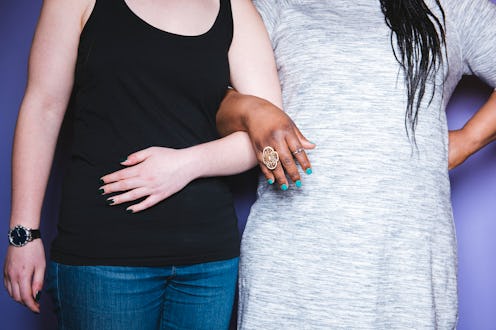
While millennials are dating non-monogamously more than any generation to come before us, somehow, polyamory, or the practice of consenting open relationships, remains on the fringes of mainstream culture and discourse. A new and wide-ranging study published this past April, however, found that 21 percent people have experienced dating non-monogamously. That's about one in five.
The study, published in the Journal of Sex & Marital Therapy, pulled its data from two of Match.com's "Singles in America" surveys — which asked participants about the nature and quality of their dating lives — to secure a data set of 8,718 single American adults. Authors clarified that non-monogamy was defined to the participants as "any relationship in which all partners agree that each may have romantic and/or sexual relationships with other partners."
Other demographic data wasn't made clear, but interestingly, the study found that the prevalence of non-monogamy stayed steady among most identity groups. Researchers wrote of the 21 percent figure, "This proportion remained constant across age, education level, income, religion, region, political affiliation, and race, but varied with gender and sexual orientation." Specifically, men and LGB-identified folks practiced non-monogamy at higher rates than women and the straight population, respectively. But the race and class data flies in the face of media portrayals which often paint poly folks as rich, white, and highly educated.
In our Tinderella-saturated dating culture, it's easy to imagine that plenty of folks who are casually dating — especially those on a dating service like Match — would remain non-exclusive. But there's no reason why non-exclusivity can't also accompany a more serious relationship if all parties can set good boundaries and maintain open lines of communication. Which is precisely why the study concluded that polyamory is prevalent enough that it needs to be regarded as a legitimate relationship model in social science circles.
"These findings suggest that a sizable and diverse proportion of U.S. adults have experienced [consensual non-monogamy (CNM)]," the study notes, "highlighting the need to incorporate CNM into theoretical and empirical therapy and family science work."
As someone who a) walked into every therapist-shopping appointment declaring that I needed them to be poly-friendly in order for us to be a good match, and someone who b) routinely emails mental health professionals for quotes, only to be told that they don't know much about polyamory, I feel uniquely qualified to give a full-throated affirmation of this conclusion. Ignoring the reality of 20 percent of the population in a health care field isn't helpful. And neither is ignoring their lived experience in a mental health practice that focuses so intently on relationships. More than helping folks who practice consenting non-monogamy feel less marginalized, the broader implications of the study fall squarely on the mental health profession.
Images: Andrew Zaeh for Bustle; Giphy